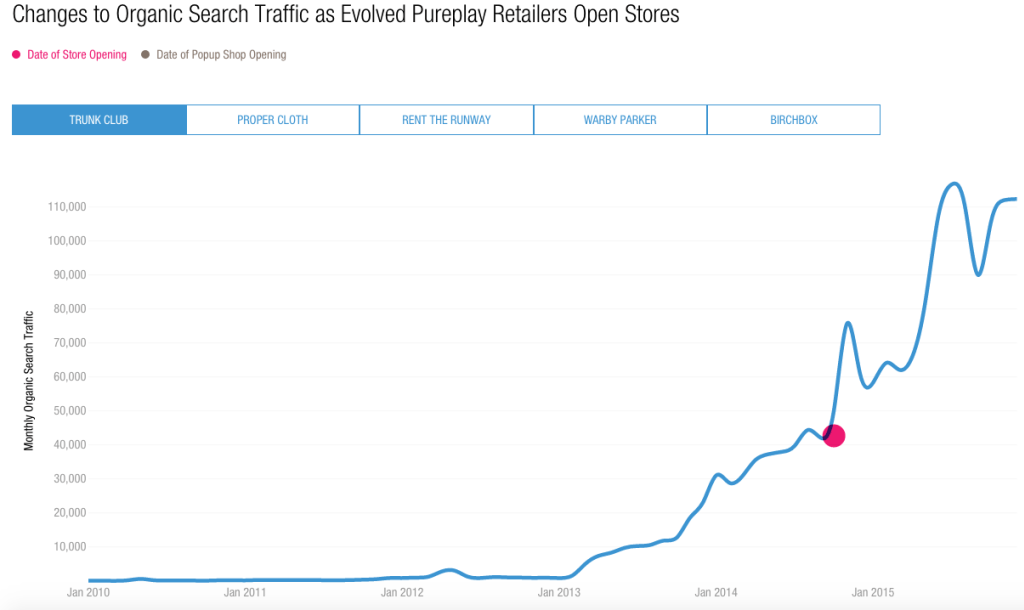Why It’s So Attractive for E-commerce Brands to Open Retail Stores
When e-commerce giants like Warby Parker, Bonobos, ModCloth, and even Amazon begin to open brick and mortar locations, you know there must be something to it. It’s a trend we’ve seen gain great traction over the last five years. And for good reason! Despite a downturn for many traditional retailers who have either found themselves in tough times or closing up shop, these e-tailers seem to not only survive the brick-and-mortar blues but thrive in this arena. And this isn’t because either of these retail mediums, digital or physical, are necessarily better than the other; it comes down to the pureplay model itself no longer being useful to today’s shopper.
What’s required by nearly all retailers is for both their digital and physical channels to merge for one cohesive brand experience. E-tailers have been quite successful in doing just that because they recognize these five core values to opening retail stores:
Retail stores are another channel on which to sell products.
The best thing that e-tailers do well is that they view the physical store as a natural extension to the digital world they’re used to rather than a challenge to it. Most e-commerce sites that take the plunge into physical retail continue to have digital at the heart of their business. For some, their locations act as showrooms with the e-commerce platform still the only way for shoppers to purchase. For others, digital manifests in other ways, but in almost every instance, the synergy between the digital and physical touchpoints is seamless.
Retail stores also offer a way for customers to see, touch, engage with the products. This has been a big concern for shoppers in the e-comm era, especially for retailers of clothes, jewelry, furniture, and many other specialties. In TimeTrade’s State of Retail 2015 Report, they found that 85% of consumers prefer to shop in-store because they like to see, touch and test products in person before buying them. Touching the product also helps dismiss doubts and give the shopper feel a perceived sense of ownership of the product, making them more likely to purchase.
The human element improves customer relationships.
As the e-comm and technology industries have grown, many feared the end of human interactions in retail. The “human touch” is important to us. In fact, TimeTrade’s 2015 Report revealed that one-third of customers want product advice from store associates, and 90% of shoppers are likely to buy after receiving help from knowledgeable staff in-store.
Physical locations with store associates help shoppers build a personal connection with the brand. Store associates are often crucial to enhancing the in-store experience, which can make or break a sale. They can help to make the experience more personal, create natural opportunities for upselling, and provide trusted information to instill confidence in the shopper.
It’s a good PR move.
The lift in press from a pop-up or store opening also correlates to a lift in online sales. The good press puts the brand’s name in front of more people, generating buzz and awareness. According to L2’s Death of Pureplay Retail report, store and pop-up openings are followed by significant increases in organic site traffic and revenue, and decreases in customer acquistion costs.
“The big benefit of the flagship stores is that they’re terrific marketing vehicles,” Jason Goldberg, senior vice-president of commerce and content at digital agency Razorfish, told Forbes. “Not only do those stores tend to be economically successful on their own but they generate a huge lift in incremental shopping to the online store.”
It’s a great way to stand out from the crowd.
Creating a great in-store experience can be a key differentiator for e-tailers, and it helps shoppers become fully immersed in the brand. By opening up this new channel, e-tailers are essentially taking the brand equity they have already from their e-commerce efforts and transferring it into a new platform. When done well, this can create long-lasting impressions with customers, making them more likely to return (and to tell their friends!).
And think of all the data!
There are tons of useful data that’s collected from the e-commerce store, but nothing gives retailers more insight into their customers than watching them shop. Seeing how they interact with products, the space, the brand in a physical setting really helps put a face to the shopper and turn them into a real person rather than just an email or IP address.
“From a market research standpoint, [a store] pays for itself. The amount of market research you gain just by observing people, it’s the equivalent of 100 focus groups,” Sucharita Mulpuru, senior analyst with Forrester Research told LSRetail.
Opening a physical storefront can be a very lucrative option for many online-only retailers. There are many advantages, and frankly, the days of pureplay are numbered. All retailers have to start thinking about the blending of their channels so that they can get the most out of their efforts, and for e-commerce players, brick and mortar bridges the gap.

